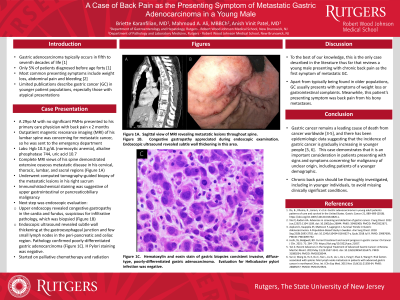Back


Poster Session C - Monday Afternoon
Category: Stomach
C0714 - A Case of Back Pain as the Presenting Symptom of Metastatic Gastric Adenocarcinoma in a Young Male
Monday, October 24, 2022
3:00 PM – 5:00 PM ET
Location: Crown Ballroom

Has Audio

Briette Karanfilian, MD
Rutgers Robert Wood Johnson University Hospital- New Brunswick
New Brunswick, NJ
Presenting Author(s)
Briette Karanfilian, MD, Mahmoud A. Ali, MBBCh, Anish Vinit Patel, MD
Rutgers Robert Wood Johnson University Hospital- New Brunswick, New Brunswick, NJ
Introduction: Gastric adenocarcinoma typically occurs in the fifth to seventh decades of life, with only 5% of patients diagnosed before age forty. Most common presenting symptoms include weight loss, abdominal pain, and bleeding. There are limited publications describing gastric cancer (GC) in younger patient populations, especially those with atypical presentations.
Case Description/Methods: A 29-year-old male with no significant medical history presented to his general practitioner with back pain for 2 months. Outpatient magnetic resonance imaging (MRI) of his lumbar spine was concerning for metastatic cancer, so he was sent to the emergency department for evaluation. Lab testing showed normocytic anemia of 10.3 g/dL, elevated alkaline phosphatase level of 744, and uric acid level of 10.7. Complete MRI views of his spine demonstrated extensive osseous metastatic disease in his cervical, thoracic, lumbar, and sacral regions (Figure 1A). The patient underwent computed tomography-guided biopsy of the metastatic lesions in his right sacrum. Immunohistochemical staining was suggestive of upper gastrointestinal or pancreaticobiliary malignancy. Therefore, he underwent endoscopic evaluation. Upper endoscopy revealed congestive gastropathy in the cardia and fundus, suspicious for infiltrative pathology, which was biopsied (Figure 1B). Endoscopic ultrasound revealed subtle wall thickening at the gastroesophageal junction and few small lymph nodes in the peri-pancreatic and celiac region. Pathology confirmed poorly-differentiated gastric adenocarcinoma (Figure 1C). H Pylori staining was negative. The patient has since been started on palliative chemotherapy and radiation.
Discussion: We report here a unique presentation of GC in a young patient. To our knowledge this is the only case described thus far that reviews a young male presenting with chronic back pain as the first symptom of metastatic GC. Apart from typically being found in older populations, GC usually presents with symptoms of weight loss or gastrointestinal complaints. This patient’s presenting symptom was back pain from his bony metastases. As GC remains a leading cause of death from cancer worldwide, this case demonstrates that it is an important consideration in patients presenting with signs and symptoms concerning for malignancy of unclear origin, including patients of a younger demographic. Additionally, chronic back pain should be thoroughly investigated including in younger individuals to avoid missing clinically significant conditions.

Disclosures:
Briette Karanfilian, MD, Mahmoud A. Ali, MBBCh, Anish Vinit Patel, MD. C0714 - A Case of Back Pain as the Presenting Symptom of Metastatic Gastric Adenocarcinoma in a Young Male, ACG 2022 Annual Scientific Meeting Abstracts. Charlotte, NC: American College of Gastroenterology.
Rutgers Robert Wood Johnson University Hospital- New Brunswick, New Brunswick, NJ
Introduction: Gastric adenocarcinoma typically occurs in the fifth to seventh decades of life, with only 5% of patients diagnosed before age forty. Most common presenting symptoms include weight loss, abdominal pain, and bleeding. There are limited publications describing gastric cancer (GC) in younger patient populations, especially those with atypical presentations.
Case Description/Methods: A 29-year-old male with no significant medical history presented to his general practitioner with back pain for 2 months. Outpatient magnetic resonance imaging (MRI) of his lumbar spine was concerning for metastatic cancer, so he was sent to the emergency department for evaluation. Lab testing showed normocytic anemia of 10.3 g/dL, elevated alkaline phosphatase level of 744, and uric acid level of 10.7. Complete MRI views of his spine demonstrated extensive osseous metastatic disease in his cervical, thoracic, lumbar, and sacral regions (Figure 1A). The patient underwent computed tomography-guided biopsy of the metastatic lesions in his right sacrum. Immunohistochemical staining was suggestive of upper gastrointestinal or pancreaticobiliary malignancy. Therefore, he underwent endoscopic evaluation. Upper endoscopy revealed congestive gastropathy in the cardia and fundus, suspicious for infiltrative pathology, which was biopsied (Figure 1B). Endoscopic ultrasound revealed subtle wall thickening at the gastroesophageal junction and few small lymph nodes in the peri-pancreatic and celiac region. Pathology confirmed poorly-differentiated gastric adenocarcinoma (Figure 1C). H Pylori staining was negative. The patient has since been started on palliative chemotherapy and radiation.
Discussion: We report here a unique presentation of GC in a young patient. To our knowledge this is the only case described thus far that reviews a young male presenting with chronic back pain as the first symptom of metastatic GC. Apart from typically being found in older populations, GC usually presents with symptoms of weight loss or gastrointestinal complaints. This patient’s presenting symptom was back pain from his bony metastases. As GC remains a leading cause of death from cancer worldwide, this case demonstrates that it is an important consideration in patients presenting with signs and symptoms concerning for malignancy of unclear origin, including patients of a younger demographic. Additionally, chronic back pain should be thoroughly investigated including in younger individuals to avoid missing clinically significant conditions.

Figure: Figure 1. [A] Magnetic resonance imaging of spine showing extensive osseous metastatic disease. [B] Upper endoscopy with congestive gastropathy. [C] Pathology demonstrating poorly-differentiated gastric adenocarcinoma.
Disclosures:
Briette Karanfilian indicated no relevant financial relationships.
Mahmoud Ali indicated no relevant financial relationships.
Anish Vinit Patel indicated no relevant financial relationships.
Briette Karanfilian, MD, Mahmoud A. Ali, MBBCh, Anish Vinit Patel, MD. C0714 - A Case of Back Pain as the Presenting Symptom of Metastatic Gastric Adenocarcinoma in a Young Male, ACG 2022 Annual Scientific Meeting Abstracts. Charlotte, NC: American College of Gastroenterology.
